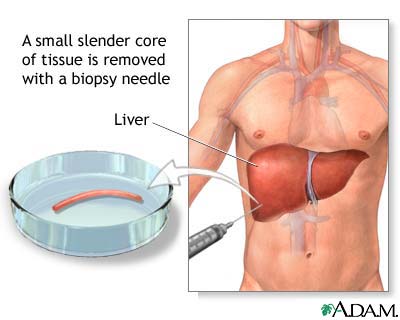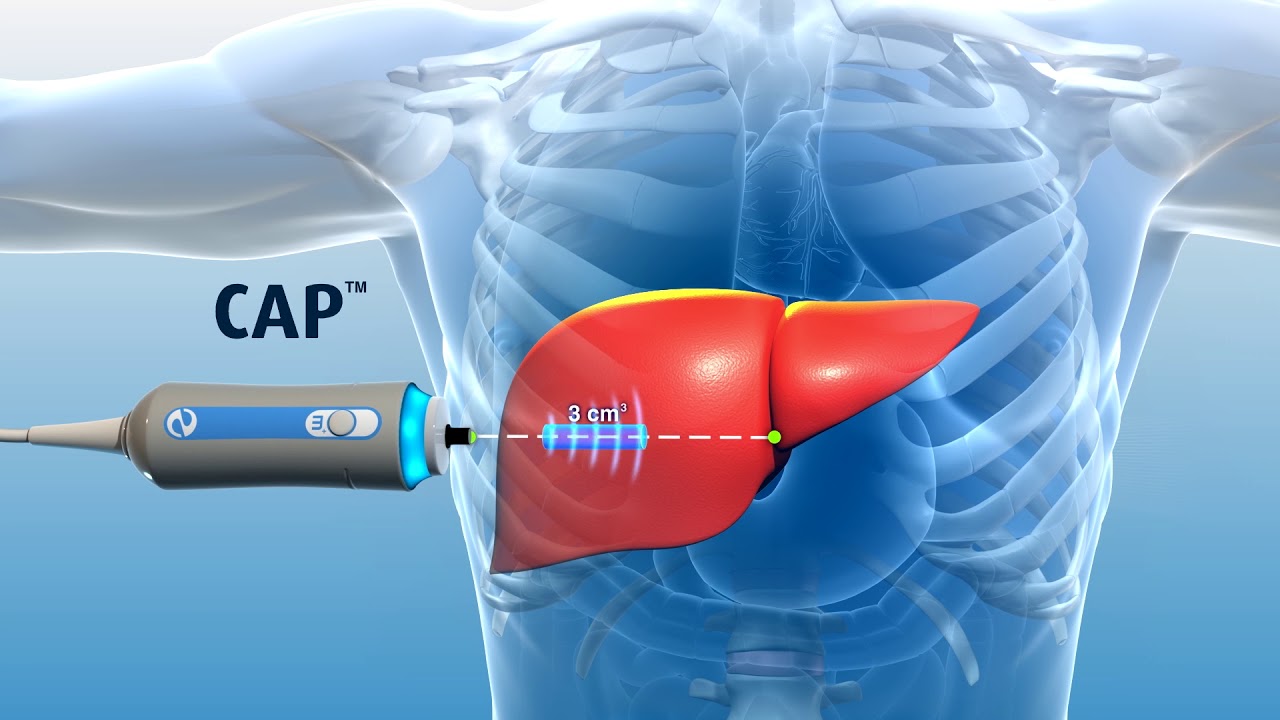
What is a liver biopsy?
A liver biopsy is a procedure that involves taking a small piece of liver tissue for examination with a microscope for signs of damage or disease. The three types of liver biopsy are the following:
-
Percutaneous biopsy—the most common type of liver biopsy—involves inserting a hollow needle through the abdomen into the liver. The abdomen is the area between the chest and hips.
-
Transvenous biopsy involves making a small incision in the neck and inserting a needle through a hollow tube called a sheath through the jugular vein to the liver.
-
Laparoscopic biopsy involves inserting a laparoscope, a thin tube with a tiny video camera attached, through a small incision to look inside the body to view the surface of organs. The health care provider will insert a needle through a plastic, tubelike instrument called a cannula to remove the liver tissue sample.

What is the liver and what does it do?
The liver is the body's largest internal organ. The liver is called the body's metabolic factory because of the important role it plays in metabolism—the way cells change food into energy after food is digested and absorbed into the blood. The liver has many functions, including
-
taking up, storing, and processing nutrients from food—including fat, sugar, and protein—and delivering them to the rest of the body when needed
-
making new proteins, such as clotting factors and immune factors
-
producing bile, which helps the body absorb fats, cholesterol, and fat-soluble vitamins
-
removing waste products the kidneys cannot remove, such as fats, cholesterol, toxins, and medications
A healthy liver is necessary for survival. The liver can regenerate most of its own cells when they become damaged.
The liver, the body's largest internal organ, has many important functions.
Why is a liver biopsy performed?
A health care provider will perform a liver biopsy to
-
diagnose liver diseases that cannot be diagnosed with blood or imaging tests
-
estimate the degree of liver damage, a process called staging
-
help determine the best treatment for liver damage or disease
How does a person prepare for a liver biopsy?
A person prepares for a liver biopsy by
-
talking with a health care provider
-
having blood tests
-
arranging for a ride home
-
fasting before the procedure
Talking with a health care provider:
People should talk with their health care provider about medical conditions they have and all prescribed and over-the-counter medications, vitamins, and supplements they take, including
-
antibiotics
-
antidepressants
-
aspirin
-
asthma medications
-
blood pressure medications
-
blood thinners
-
diabetes medications
-
dietary supplements
-
nonsteroidal anti-inflammatory drugs such as ibuprofen and naproxen
The health care provider may tell the person to stop taking medications temporarily that affect blood clotting or interact with anesthesia, which people sometimes receive during a liver biopsy.
Having blood tests. A person will have a test to show how well his or her blood clots. A person will have a test to show how well his or her blood clots. A technician or nurse draws a blood sample during an office visit or at a commercial facility and sends the sample to a lab for analysis. People with severe liver disease often have blood-clotting problems that can increase their chance of bleeding after the biopsy. A health care provider may give the person a medication called clotting factor concentrates just before a liver biopsy to reduce the chance of bleeding.
Arranging for a ride home after the procedure. For safety reasons, most people cannot drive home after the procedure. A health care provider will ask a person to make advance arrangements for getting home after the procedure.
Fasting before the procedure.A health care provider will ask a person not to eat or drink for 8 hours before the procedure if the provider anticipates using anesthesia or sedation.
How is a liver biopsy performed?
A health care provider performs the liver biopsy at a hospital or an outpatient center and determines which type of biopsy is best for the person.
Percutaneous liver biopsy is the most common type of liver biopsy.
Percutaneous Liver Biopsy
A person lies face up on a table and rests the right hand above the head. A health care provider gives the person a local anesthetic on the area where he or she will insert the biopsy needle. If needed, the health care provider will give the person sedatives and pain medication.
The health care provider either taps on the abdomen to locate the liver or uses one of the following imaging techniques:
-
Ultrasound. Ultrasound uses a device, called a transducer, that bounces safe, painless sound waves off organs to create an image of their structure.
-
Computerized tomography (CT) scan. A CT scan uses a combination of x-rays and computer technology to create images. For a CT scan, a technician may give the person a solution to drink and an injection of a special dye, called contrast medium. CT scans require the person to lie on a table that slides into a tunnel-shaped device where the technician takes the x-rays.
Research has shown fewer complications after biopsy when health care providers use ultrasound to locate the liver compared with tapping on the abdomen.1 Health care providers may select ultrasound over a CT scan because it is quicker and less expensive, and can show the biopsy needle in real time.2
The health care provider will
-
make a small incision in the right side of the person's abdomen, either toward the bottom of or just below the rib cage
-
insert the biopsy needle
-
ask the person to exhale and hold his or her breath while the health care provider inserts the needle and quickly removes a sample of liver tissue
-
insert and remove the needle several times if multiple samples are needed
-
place a bandage over the incision
After the biopsy, the person must lie on his or her right side for up to 2 hours to reduce the chance of bleeding. Medical staff monitor the person for signs of bleeding for 2 to 4 more hours.
Transvenous Liver Biopsy
When a person's blood clots slowly or the person has ascites—a buildup of fluid in the abdomen—the health care provider may perform a transvenous liver biopsy.
For this procedure, the person lies face up on an x-ray table, and a health care provider applies local anesthetic to one side of the neck. The health care provider will give sedatives and pain medication if the person needs them.
The health care provider will
-
make a small incision in the neck
-
insert a sheath into the jugular vein and thread the sheath down the jugular vein, along the side of the heart, and into one of the veins in the liver.
-
inject contrast medium into the sheath and take an x-ray. The contrast medium makes the blood vessels and the location of the sheath clearly visible on the x-ray images.
-
thread a biopsy needle through the sheath and into the liver and quickly remove a liver tissue sample.
-
insert and remove the biopsy needle several times if multiple samples are needed.
-
carefully withdraw the sheath and close the incision with a bandage.
Medical staff monitor the person for 4 to 6 hours afterwards for signs of bleeding.
Laparoscopic Liver Biopsy
Health care providers use this type of biopsy to obtain a tissue sample from a specific area or from multiple areas of the liver, or when the risk of spreading cancer or infection exists. A health care provider may take a liver tissue sample during laparoscopic surgery performed for other reasons, including liver surgery.
The person lies on his or her back on an operating table. A nurse or technician will insert an intravenous (IV) needle into the person's arm to give anesthesia. The health care provider will
-
make a small incision in the abdomen, just below the rib cage
-
insert a thin tube into the incision and fill the abdomen with gas to provide space to work inside the abdominal cavity and to see the liver
-
insert a biopsy needle through the cannula and into the liver and quickly remove a liver tissue sample
-
insert and remove the biopsy needle several times if multiple samples are needed
-
remove the thin tube and close the incisions with dissolvable stitches
The health care provider can easily spot any bleeding from the procedure with the camera on the laparoscope and treat it using an electric probe. The person stays at the hospital or an outpatient center for a few hours while the anesthesia wears off.
What can a person expect after a liver biopsy?
After a liver biopsy, a person can expect
-
full recovery in 1 to 2 days.
-
to avoid intense activity, exercise, or heavy lifting for up to 1 week.
-
soreness around the biopsy or incision site for about a week. Acetaminophen (Tylenol) or other pain medications that do not interfere with blood clotting may help. People should check with their health care provider before taking any pain medications.
-
a member of the health care team to review the discharge instructions with the person—or with an accompanying friend or family member if the person is still groggy—and provide a written copy. The person should follow all instructions given
Liver biopsy results take a few days to come back. The liver sample goes to a pathology lab where a technician stains the tissue. Staining highlights important details within the liver tissue and helps identify any signs of liver disease. The pathologist—a doctor who specializes in diagnosing diseases—looks at the tissue with a microscope and sends a report to the person's health care provider.
What are the risks of liver biopsy?
The risks of a liver biopsy include
-
pain and bruising at the biopsy or incision site—the most common complication after a liver biopsy. Most people experience mild pain that does not require medication; however, some people need medications to relieve the pain.
-
prolonged bleeding from the biopsy or incision site or internal bleeding. A person may require hospitalization, transfusions, and sometimes surgery or another procedure to stop the bleeding.
-
infection of the biopsy site or incision site that may cause sepsis. Sepsis is an illness in which the body has a severe response to bacteria or a virus.
-
pneumothorax, also called collapsed lung, which occurs when air or gas builds up in the pleural space. The pleural space is thin layers of tissue that wrap around the outside of the lungs and line the inside of the chest cavity. Pneumothorax may happen when the biopsy needle punctures the pleural space.
-
hemothorax, or the buildup of blood in the pleural space.
-
puncture of other organs.
Seek Immediate Care
People who have any of the following symptoms after a liver biopsy should seek immediate medical attention:
-
chest pain
-
difficulty breathing
-
increasing abdominal pain
-
dizziness
-
bleeding from the incision or biopsy site
-
abdominal swelling or bloating
-
fever
-
swelling or redness at the incision or biopsy site
-
nausea or vomiting

